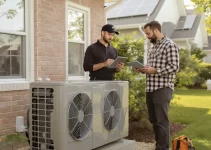When it comes to upgrading your home or business heating and cooling, ductless heat pump systems are rapidly becoming the go-to solution. In 2025, advances in technology, generous incentives, and growing climate concerns have propelled these systems into the mainstream. Whether you’re replacing an aging furnace or adding comfort to a new space, a ductless air source heat pump offers efficient, flexible, and sustainable performance.
Understanding Ductless Heat Pump Systems
A ductless heat pump, often called a mini-split, uses an outdoor compressor unit and one or more indoor air-handling units connected by refrigerant lines. Unlike central HVAC systems, they don’t require ductwork, making installation simpler and more adaptable.
Mini-splits can be a smart alternative, especially if you want to avoid the seasonal hassle of window units. They offer comfort closer to central air with more flexibility in zoning.
— Chris Regan
These systems draw heat from outdoor air (even in cold weather) and transfer it indoors during winter, reversing the process in summer to cool your space. Modern air source heat pumps can operate efficiently down to -13°F (-25°C), thanks to cold climate engineering.
Why Energy Efficiency Matters
Energy efficiency is at the heart of ductless heat pump adoption. SEER ratings for top models range from 20–30, and HSPF ratings often exceed 10. This can translate into up to 40% lower energy bills compared to electric resistance heating.
| Metric | Typical Value | Benefit |
|---|---|---|
| SEER Rating | 20–30 | Lower cooling costs |
| HSPF Rating | >10 | Lower heating costs |
| Energy Savings | Up to 40% | Reduced utility bills |
As shown above, these ratings indicate how effectively a system uses electricity to deliver heating or cooling. The higher the rating, the more efficient the system.
Installation Process: Step-by-Step
Installing a ductless heat pump typically takes 1–2 days and involves:
- Site assessment – Determine optimal placement for indoor units and outdoor condenser.
- Mounting indoor units – Wall-mounted or ceiling cassette units installed where needed.
- Installing outdoor unit – Positioned for airflow and maintenance access.
- Connecting refrigerant lines – Linking indoor and outdoor units.
- Electrical connections – Power supply setup.
- System testing – Ensuring proper operation.
While professional installation is recommended, models like the Mr Cool DIY Series allow skilled homeowners to handle the process themselves. For a full homeowner guide, check out Heat Pump Installation: A Step-by-Step Homeowner Guide.
Benefits Beyond Efficiency
Zoned Comfort
Ductless systems allow you to heat or cool specific areas rather than the entire building, which is perfect for additions, home offices, or rarely used rooms.
Improved Air Quality
Advanced filtration captures dust, pollen, and other allergens, which can significantly improve indoor air.
Quiet Operation
Most systems run far quieter than window units or central systems, enhancing comfort.
The latest generation of ductless heat pumps combines inverter technology, high SEER ratings, and smart controls — making them the most cost-effective and future-proof choice for home heating and cooling.
— Doctor Heat Pump
Best Models in 2025
Here are some top-performing ductless heat pump systems this year:
| Model | Key Feature | Best Use |
|---|---|---|
| Mitsubishi Electric Hyper Heat | Cold climate performance | Homes in freezing regions |
| Daikin Aurora Series | Advanced filtration | All-season comfort |
| Mr Cool DIY Series | Easy installation | DIY projects |
| Fujitsu Halcyon XLTH | Reliable subzero operation | Northern climates |
| LG Multi V S | Smart connectivity | Modern homes |
Each model offers unique strengths. Mitsubishi and Daikin excel in cold climates, while Mr Cool appeals to DIY enthusiasts.
Incentives and Cost Savings
Thanks to the Inflation Reduction Act, homeowners may qualify for up to $8,000 in rebates for installing a qualifying heat pump. Many states also offer tax credits or utility rebates.
When comparing costs, remember to factor in long-term savings from reduced energy bills. For a detailed cost-benefit analysis, see Heat Pump vs Furnace: Which Offers Better Home ROI.
Maintenance Tips
Annual filter cleaning and coil inspections are essential. Every 2–3 years, schedule professional servicing to maintain peak efficiency.
Common mistakes to avoid:
- Oversizing the unit, which can cause short cycling.
- Neglecting maintenance, leading to reduced efficiency.
- Incorrect placement that hampers airflow.
For a detailed guide, check Heat Pump Maintenance & Troubleshooting Guide for Homeowners.
Future Trends
Cold climate certifications from AHRI are making it easier for consumers to identify systems suited for freezing temperatures. Smart controls with app integration are now standard, and inverter-driven compressors ensure steady temperatures with minimal energy use.
Industry experts predict ductless heat pumps will account for over 20% of residential HVAC installations by 2025, reflecting strong market growth.
Conclusion
Ductless air source heat pumps in 2025 represent a fusion of efficiency, flexibility, and sustainability. With leading models from Mitsubishi, Daikin, and others, plus robust incentives and evolving cold climate technology, now is an excellent time to make the switch.
Whether you’re seeking lower bills, improved comfort, or reduced environmental impact, a ductless system can deliver. Start by assessing your space, budget, and climate needs — then choose a model that aligns with your goals.
By investing in a ductless heat pump today, you’re not just upgrading your comfort — you’re future-proofing your home or business for a greener tomorrow.


